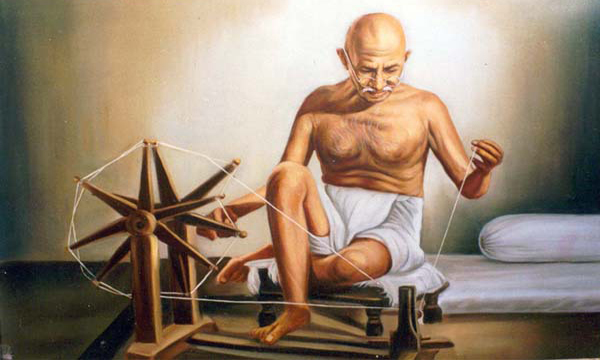“If we have the ‘khadi spirit’ in us, we would surround ourselves with simplicity in every walk of life. The ‘khadi spirit’ means illimitable patience. For those who know anything about the production of khadi and know how patiently the spinners and the weavers have to toil at their trade, and even so must we have patience while we are spinning ‘the thread of Swaraj’” — Mahatma Gandhi
Mahatma Gandhi didn’t just revive India’s flagging khadi industry, he also encouraged people across India to boycott British-made clothes, spin their own yarn and wear khadi. He encouraged them to rediscover pride in their heritage while lending support to their rural brethren. The word ‘khadi’ is derived from ‘khaddar,’ a term for handspun fabric in India, Bangladesh and Pakistan. While khadi is usually manufactured from cotton, it is also made from silk and woollen yarn (called khadi silk and khadi wool, respectively). Several Indian designers such as Neeta Lulla, Nachiket Barve, and Ritu Beri have showcased khadi at the national and international levels, giving it an haute makeover.
Trijogi Narayan Das, Deputy Secretary of Odisha Khadi and Village Industries Board, says, “Khadi is completely hand spun and hand woven. It is different from handloom in that it is completely handmade, whereas yarns for handloom fabrics are processed at mills. Over the last few years, Prime Minister Narendra Modi has left no stone unturned to popularise khadi and create a mass movement where everyone purchases khadi products, especially on Gandhi Jayanti. The prime minister says that when we purchase khadi, we are brightening the lives of the lakhs of weavers who toil day and night.”
“The Indian Navy recently opted for khadi uniforms for one of its batches. Uttarakhand’s postal department too ordered khadi cotton and woollen garments for its employees. And Air India has decided to use khadi products for its amenity kits on international flights. Besides, the central government has said that products like bedsheets, abdomen sheets, dressing towels, surgeon gowns made out of khadi and herbal shampoos will soon be used in government hospitals across the country.”
The handspun, natural and organic fabric of khadi is ideal for Indian weather conditions and keeps the wearer cool in summer. It is a skin-friendly fabric that ‘breathes’ and no chemicals are used in its manufacture. From layered khadi kurtas to khadi sarees, short and long kurtas, jackets, fatehi, gamchha, and bags for men and women, a range of khadi products are available in the market and in khadi outlets in the city. “Only institutions that have a certificate from the Khadi Village Industries Commission (KVIC) are eligible to manufacture khadi garments,” adds Trijogi.
Bhubaneswar-based fashion designer Jeet Jagjit says, “Previously, khadi fabrics were generally associated with the Swadeshi movement. This has changed. From being the apparel of a patriot, it has become a fashion fabric. Initially, the roughness of the fabric did not appeal to fashion savvy people. But, now there is a growing demand for khadi apparel.”
“Wearing handloom is a popular fashion trend among today’s young generation. Today, khadi fabrics are not limited to cotton. Khadi can be blended with other fibres to make raw silk khadi, matka khadi, poly khadi, tussar silk, and so on. Ethnic khadi has captured the imagination of dress designers and is a favoured fabric on the ramp. Besides dresses, carrying a khadi bag is also considered trendy. The lightweight bags are apt for all ages, pocket friendly, and can go with any outfit,” adds Jeet.
Fashion designer Vishwat Sen says, “The eco-friendly fabric was always known for its rugged texture, comfortable feel and ability to keep people warm in winter as well as cool in summer. Its new-age reinterpretation as a modern yet quintessentially Indian textile has made it very appealing to the millennial generation.”
“If khadi clothes are made in cutting edge designs at par with global designs, they will automatically appeal to the youth. Today, khadi is being used for traditional as well as Indo-western apparel. We have fused khadi with Ikat, hand embroidery, and batik in our designs. Khadi gives an elegant look, especially in white. So, we use white khadi fabric and enhance it with batik and hand embroidery. Using a pleating technique in front and combining it with Ikat lends a royal look to men’s kurtas,” adds Vishwat.
Bangalore-based fashion designer Puja Deo says that salwar kameez sets made from khadi cotton are very popular among women. These can either be printed or embroidered on, depending on the design. Khadi sarees, however, are not as popular as salwar kameez sets as they have an extremely starched and stiff look, a characteristic of the fabric. Cotton khadi fabric is also used to create accessories for women such as handbags, especially sling bags.
Puja suggests that khadi cotton kurtis be teamed up with funky jewellery. Street jewellery that comes in the form of beaded necklaces and bracelets also goes well with khadi outfits. Very few women choose to wear traditional Indian jewellery with khadi attire as the juxtaposition does not look good.
Sarah Banoo, an MBA from Cuttack, says, “The soothing colours make khadi a favourite of many, irrespective of age. Because of the versatile quality of khadi – cool in summer and warm in winter – I have included a variety of khadi dresses in my wardrobe. I usually prefer khadi kurtis with salwars for a formal meet. You can match the kurtis with jeans for an informal event.”
Abinash Patnaik, a government agriculture officer, says, “I wear khadi kurtas, shirts, fatehi, and jackets because they are comfortable. Khadi garments are good both for summer and winter days. Khadi is durable, lightweight and resistant to multiple washes and so that is another reason to choose the fabric.”
Bratati Baral, OP






































